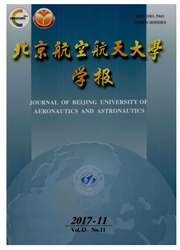

 中文摘要:
中文摘要:
针对超临界层流翼型设计问题,提出一种两轮优化策略。采用γ-Reθt转捩模型耦合剪切应力输运(SST)模式的湍流模型对翼型边界层转捩进行预测。翼型几何参数化建模采用形状分类函数转换(CST)方法,设计变量为描述翼型几何特征的参数。第1轮优化的目的是尽量提高层流区域的比例,气动分析模型为基于Kriging模型的代理模型,优化算法为遗传算法,通过优化获得满足约束要求的层流翼型。第2轮优化目的是对第1轮优化获得的翼型进行微调,进一步提高翼型的升阻比,气动分析直接采用CFD程序,优化算法采用基于梯度的优化算法。算例表明,应用本文提出的两轮优化策略,可将超临界翼型NASA SC(2)0412优化设计成超临界层流翼型,翼型的上下表面层流区比例分别达到了55.5%和47.0%,升阻比提高了38.1%。
 英文摘要:
英文摘要:
A two-step optimization strategy for the supercritical laminar flow airfoil design is proposed in the paper. The γ-Reθttransition model coupled with the shear stress transportation( SST) turbulence model is used for prediction of airfoil boundary layer transition. The Class/Shape Transformation( CST) method is used to parameterize airfoil geometry. The parameters in the airfoil geometry model are used as the design variables.The first step of optimization is to increase the ratio of the laminar flow region. A genetic algorithm based on the Kriging surrogate model is employed to obtain the laminar flow airfoil with all constraints satisfied. The second step of optimization is to improve the optimization result of the first step,and to further increase the liftto-drag ratio of the airfoil. A gradient based optimization is used to search optimal solution. The aerodynamic analysis during the second step optimization is implemented through the CFD code rather than the surrogate model. The example demonstrates that the supercritical airfoil NASA SC( 2) 0412 can be optimized into a supercritical laminar flow airfoil by the two-step optimization method,the laminar region ratios on the airfoil upper and lower surface increase by 55. 5% and 47. 0% respectively,and the lift-to-drag ratio increases by 38. 1%.
 同期刊论文项目
同期刊论文项目
 同项目期刊论文
同项目期刊论文
 期刊信息
期刊信息
